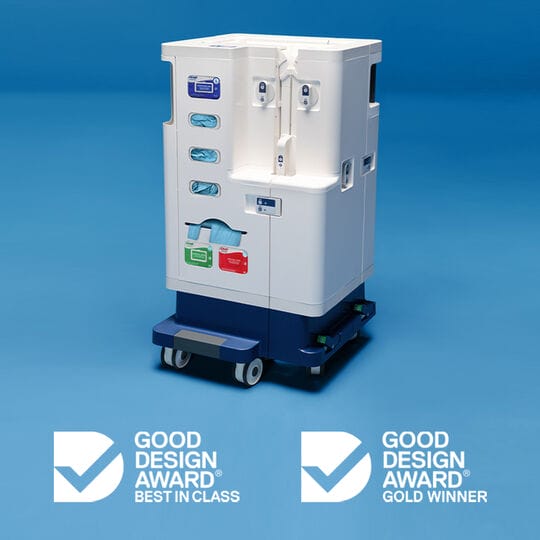Posted
12th November 2021
Research
In this article we discuss the strain on isolation capacity in hospitals, the financial impact of hospital acquired infections (HAIs) and how Rediroom is an effective isolation solution.
Why do we need to isolate in hospitals?
Isolation of patients with communicable illnesses is a key aspect to preventing HAIs, alongside regular, thorough cleaning and disinfection of surfaces and hands. Isolation can either be achieved through admitting a patient to a single occupancy room, or in an allocated room with other infected patients. Common conditions and infections that need to be isolated in healthcare settings include: Clostridium difficile infection, norovirus, Methicillin-resistant Staphylococcus aureus (MRSA), and infections caused by multi drug resistant Gram negative bacteria. In addition, patients in healthcare organisations with suspected or unconfirmed infections, also require isolation.
What happens when isolation capacity is strained?
Hospitals with insufficient or strained isolation capacity have to continually undertake risk assessments and move patients in and out of isolation, so that those that present the greatest risk at any given time are isolated. This system not only increases the risk of disease transmission, but also is confusing and time consuming for patients and staff. The COVID-19 pandemic has put unprecedented strain on the isolation capacity of health systems around the world, and shone a light on the need for flexible, cost-effective solutions to increase isolation capacity. Going forward, we need to make sure the lessons learnt during this time are permanent, and that healthcare systems around the world are better prepared to prevent infections spreading.
What can we do?
At GAMA Healthcare, we have developed Rediroom, the world’s first mobile isolation solution that is intended to augment a healthcare provider’s existing isolation capacity when demand exceeds supply. Rediroom is a cart that expands to create a single patient use isolation room that can be installed in any suitable space or around a patient bed space in under five minutes. It features a non-touch door mechanism and in-built HEPA and carbon filters that draws air from within the room out of it via a fan. Designed to mitigate the risk of HAIs spread via droplet and contact transmission, Rediroom is already being used in 30 NHS hospitals to increase isolation capacity, allowing hospitals to reduce the risk of hospital acquired infections (HAIs) that are spread through droplet and skin contact, including norovirus, seasonal flu, C. diff, and MRSA.
Rediroom
A mobile cart that expands into a HEPA air-filtered single room with hands-free entry, provides hospitals with greater isolation capacity and flexibility, improving patient flow.
What are the health economics implications of this?
A 2021-published UK-based study on the financial impact of HCAIs showed that in the NHS in Scotland alone, with a loss of over 58,000 bed days per annum, the average cost of a healthcare-associated infection was calculated as £6232, with an annual national cost of £46.3 million.[1] This equates to a total cost of £774 million for the whole of the UK. More recent research reported that if the implementation of Rediroom to isolate infected and colonised patients only reduced transmission by a conservative figure of 16.5%, it would be likely to be a cost-effective practice for the NHS.[1]
RELATED ARTICLE: The cost-effectiveness of temporary patient isolation rooms in reducing HCAI
Evidence supporting use of Rediroom
In response to the pandemic, 28 NHS Provider organisations purchased a total of 279 Rediroom carts, leading to an overall 1% increase in the isolation capacity of the entire NHS in England, an average of 5% within the purchasing organisations, and with one organisation increasing its capacity by 12%. Even when the role of aerosol became clearer in the transmission of COVID, hospitals continued to purchase and utilise Rediroom, as local risk assessments lead to users determining that it was an acceptable off-label solution to the problem of a shortage of isolation facilities, with it forming a part of hospitals’ COVID response.
Conclusions
The experiences of the pandemic, and the benefits brought about in the UK by Rediroom show that the ability to flexibly increase isolation capacity anywhere within a hospital is hugely valuable when this capacity is stretched. Going forward, illnesses such as seasonal flu, or the threat of infections caused by antibiotic resistant bacteria, will mean that isolation capacity should be rising on the priority lists of healthcare systems around the world. Doing this adequately will be allow us to reduce the rates of HAIs around the world. We believe that Rediroom provides one potential solution to help the world ready itself for coming healthcare challenges.
To find out more about our patient isolation room, visit our Rediroom page. Help spread the word by sharing this article on social.
[1] Graves N, Mitchell BG, Otter JA, Kiernan MA. The cost effectiveness of temporary single patient rooms to reduce risks of healthcare associated infection. J Hosp Infect. Jul 8 2021.
SHARE THIS ARTICLE
Tags
Latest News
Norovirus: Understanding its transmission and prevention in the UK
Introduction Norovirus is recognised as the leading cause of viral gastroenteritis…
Clean Between to Reduce Healthcare-Associated Infections
Healthcare-associated infections (HAIs) are a significant concern for healthcare facilities…
Mpox: emergence of a new threat
A new threat related to mpox is emerging, in the…
Wiping away infections – the CLEEN way!
Cleaning shared medical equipment with a disinfectant wipe at least…






